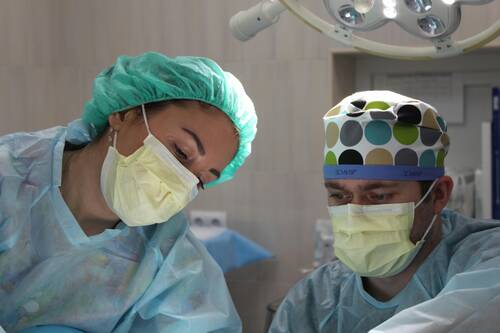
22 Nov Addressing Physician Shortages with Open Source M.D.’s Unique Approach
In the United States, physician shortages have become a national crisis, with experts projecting a shortfall of up to 124,000 doctors by 2034.
This growing gap threatens the quality of healthcare, particularly in rural and underserved areas. Hospitals and clinics are feeling the pressure, scrambling to ensure effective, reliable, and consistent medical services.
But what if there was an innovative way to address these shortages head-on? Enter Open Source M.D., a company that’s revolutionizing healthcare staffing with a fresh and agile approach. This article dives into their model, offering insight into how it could reshape the landscape of modern medical services.
Understanding the Physician Shortage Problem
The physician shortage issue isn’t just about numbers—it has a domino effect on patient care, community health, and the overall efficiency of healthcare systems. Several factors contribute to this crisis:
- Aging Population: As the baby boomer generation ages, the demand for medical services increases exponentially.
- Physician Retirement: With a significant portion of the current physician workforce nearing retirement, a large gap is left in their wake.
- Burnout and High Turnover: Long hours, administrative burdens, and high stress lead to burnout, prompting many doctors to leave the profession early.
These challenges call for a transformative approach that goes beyond traditional recruitment and staffing methods.
Why Traditional Staffing Models Are Failing
Hospitals have relied on traditional staffing models, such as locum tenens and full-time employment, to meet their needs. However, these models come with significant limitations:
- High Costs: Recruiting and retaining full-time physicians is costly, often requiring extensive benefits packages and incentives.
- Inconsistent Coverage: Locum tenens physicians may fill gaps but often lack continuity of care, disrupting patient relationships and hospital workflow.
- Burnout Risks: Overworking available physicians to fill staffing voids only exacerbates burnout and turnover.
These issues underscore the need for a more flexible and effective staffing solution.
The Open Source M.D. Staffing Model: A Game Changer
This staffing model has been developed to address physician shortages by offering efficient, cost-effective, and high-quality hospitalist services.
Here’s how it works:
Flexibility and Scalability
Unlike rigid staffing methods, this model provides a flexible, scalable approach that adapts to the changing needs of hospitals. This means healthcare facilities can quickly ramp up or scale down services as needed. Whether during a patient surge or a physician’s leave of absence, this model delivers adaptable solutions that maintain continuity of care.
High-Quality Hospitalist Services
One of the standout features of this approach is the emphasis on effective hospitalist services. By leveraging a team of experienced hospitalists, the model ensures patients receive dedicated and consistent care. This not only reduces hospital readmission rates but also improves patient outcomes and satisfaction.
Cost-Efficient Solutions
In a time when healthcare budgets are stretched thin, affordability is crucial. This staffing model helps healthcare facilities optimize costs by eliminating expensive recruitment and reducing reliance on locum tenens. It provides top-tier medical professionals without the financial strain associated with traditional staffing.
How Open Source M.D. Creates a Strong Physician Network
This approach doesn’t just fill staffing gaps; it cultivates a robust network of physicians dedicated to delivering exceptional care. Here’s how:
- Support and Well-Being: The model prioritizes the well-being of their physicians, offering reasonable work schedules and administrative support to prevent burnout.
- Ongoing Training: Continuous development ensures medical staff stay current with best practices and advancements in healthcare.
- Collaborative Culture: By fostering a culture of collaboration, physicians feel valued and empowered, which translates into better patient care and higher job satisfaction.
This unique approach strengthens the overall healthcare system and helps to retain skilled physicians in the workforce longer.
Real-World Success Stories
This staffing model has already made a significant impact in various healthcare settings. For example, one rural hospital that struggled to maintain adequate staffing saw a marked improvement in patient outcomes after adopting this approach. The seamless integration of hospitalist services resulted in shorter wait times, fewer readmissions, and higher patient satisfaction scores.
Another urban hospital facing high turnover rates found stability through the physician network cultivated by this model. The focus on physician well-being and flexible scheduling transformed the work environment, reducing burnout and promoting a positive atmosphere.
Why This Model Is the Future of Healthcare Staffing
This innovative approach goes beyond just filling physician gaps—it offers a sustainable, scalable solution that addresses the root causes of shortages. By focusing on physician well-being, flexibility, and cost efficiency, it sets a new standard for healthcare staffing models. As the physician shortage crisis continues to grow, hospitals must adapt or risk declining patient care. This model provides a roadmap to a better future for both patients and healthcare professionals.
Building a Sustainable Healthcare Future
The physician shortage is a complex issue that requires innovative solutions. Open Source M.D. has emerged as a leader in this space, offering a unique and effective approach that benefits hospitals, doctors, and patients alike. Their flexible and scalable staffing model ensures high-quality care while addressing the financial and operational challenges faced by healthcare facilities. As the demand for medical services continues to rise, adopting forward-thinking strategies will be crucial for sustaining healthcare quality.
———————–
The information on MedicalResearch.com is provided for educational purposes only, and is in no way intended to diagnose, cure, or treat any medical or other condition.
Some links are sponsored. Products and services are not tested, warranted or endorsed.
Always seek the advice of your physician or other qualified health and ask your doctor any questions you may have regarding a medical condition. In addition to all other limitations and disclaimers in this agreement, service provider and its third party providers disclaim any liability or loss in connection with the content provided on this website.
Last Updated on November 22, 2024 by Marie Benz MD FAAD
